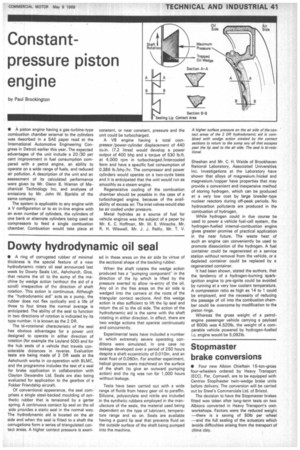Dowty hydrodynamic oil seal
Page 43

If you've noticed an error in this article please click here to report it so we can fix it.
• A ring of corrugated rubber of minimal thickness is the special feature of a new hydrodynamic rotary oil seal announced last week by Dowty Seats Ltd., Ashchurch, Gios, that returns the oil to the sump of the machine by wedge action (without the aid of a scroll) irrespective of the direction of shaft rotation. This action is continuous. Although the "hydrodynamic aidacts as a pump, the rubber does not flex cyclically and a life of three to four times the normal average is anticipated. The ability of the seal to function in two directions of rotation is indicated by its type number. It is known as the 2 DR.
The bi-rotational characteristic of the seat has obvious advantages for a power unit designed to operate in either direction of rotation (for example the Leyland 500) and for the hub seals of a vehicle that travels considerable distances in reverse. Evaluation tests are being made of 2 DR seals at the Ashchurch works in co-operation with BLMC, and the programme includes the test of a seal for brake application in collaboration with Clayton Dewandre Ltd. Seals are also being evaluated for application to the gearbox of a Fokker Friendship aircraft.
Of conventional appearance, the seal cornprises a single steel-backed moulding of synthetic rubber that is tensioned by a garter spring. A continuous contact lip seal on the oil side provides a static seal in the normal way. The hydrodynamic aid is located on the air side and when the seal is fitted to a shaft the corrugations form a series of triangulated contact areas. A higher contact pressure is exert
ed in these areas on the air side by virtue of the sectional shape of the backing rubber.
When the shaft rotates the wedge action produced has a -pumping component" in the direction of the lip which is lifted by the pressure exerted to allow re-entry of, the oil. Any oil in the free areas on the air side is wedged into the corners at the roots of the triangular contact sections. And this wedge action is also sufficient to lift the lip seal and return the oil to the oil side. The action of the hydrodynamic aid is the same with the shaft rotating in either direction. In effect, there are two wedge actions that operate continuously and concurrently.
Experimental tests have included a number in which extremely severe operating conditions were simulated. In one case no leakage developed over a period of 250 hours despite a shaft eccentricity of 0.010in, and an axial float of 0.060in. For another experiment, helical grooves were machined on the surface of the shaft Ito give an outward pumping action) and the rig was run for 1,000 hours without leakage.
Tests have been carried out with a wide range of fluids from heavy gear oil to paraffin. Silicone, polyacrylate and nitrile are included in the synthetic rubbers employed in the manufacture of the seals, the material used being dependent on the type of lubricant, temperature range and so on. Seals are available having a guard lip seal that prevents fluid on the outside surface of the shaft being pumped into the machine. Sheehan and Mr. C. H. Weide of Brookhaven National Laboratory, Associated Universities inc. Investigations at the Laboratory have shown that alloys of magnesium /nickel and magnesium /copper have properties that may provide a convenient and inexpensive method of storing hydrogen, which can be produced at a very low cost by large breeder-type nuclear reactors during off-peak periods. No hydrocarbon pollutants are produced in the combustion of hydrogen.
While hydrogen could in due course be used to power a vehicle fuel-cell system, the hydrogen-fuelled internal-combustion engine gives greater promise of practical application in the near future. The waste heat of such an engine can conveniently be used to promote dissociation of the hydrogen. A fuel container could be regenerated at a service station without removal from the vehicle, or a depleted container could be replaced by a regenerated container.
It had been shown, stated the authors, that the tendency of a hydrogen-burning sparkignition engine to pre-ignite could be avoided by running at a very low coolant temperature. A compression ratio as high as 14 to 1 could be employed, and the necessity of reducing the passage of oil into the combustion chamber could be overcome by modification to the piston rings.
Whereas the gross weight of a petrolengine passenger vehicle carrying a payload of 8001b was 4,520Ib, the weight of a comparable vehicle powered by hydrogen-fuelled Lc. engine would be 5,092Ib.


















































































































